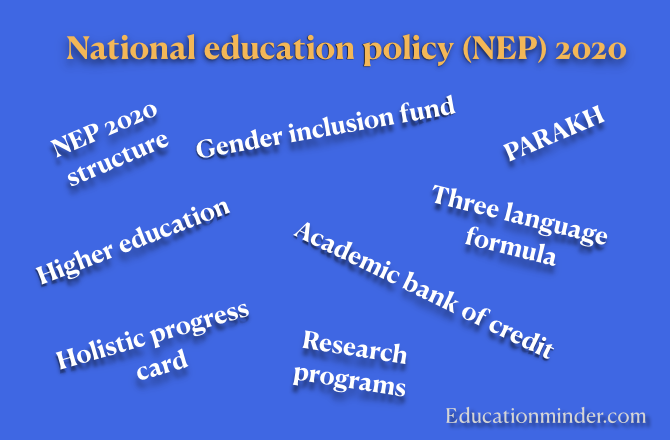National education policy (NEP) 2020 is a comprehensive policy. It was approved by an indian government in July 2020. It is the first education policy of the 21st century. NEP 2020 aims to bring about significant changes in the Indian education system from the pre-primary level to the higher education level.
Aims and objectives of NEP 2020
The main aims and objectives of the NEP 2020 are as follows:
1. To promote multilingualism.
2. To enhance the quality of education and research in India.
3. To make India a global education hub.
4. To provide equitable quality education to all students irrespective of their social, cultural, and economic backgrounds.
5. To make the curriculum flexible and to the reach of children.
6. To make overall development of children i.e; physical, social, emotional and, cognitive development.
7. To foster critical thinking and ethical values among learners.
8. To prepare the children for the future.
Highlights of NEP 2020
NEP 2020 is the third educational policy of India. It has replaced 34 year old education policy, NEP 1986 ( modified as POA 1992). K. Kasturirangan was the chairman of national education policy 2020 committee. Important highlights and key recommendations of NEP 2020 are:
1. NEP 2020 structure
The old education structure 10+2 has been replaced by 5+3+3+4 structure. This 5+3+3+4 format covers foundational stage, preparatory stage, middle stage, secondary stage, and higher secondary stage.
● Foundational stage: It is the first and most crucial stage of child education. As its name suggests it provides a strong foundation for learning. It is aimed at children aged between 3-8 years. There is a provision of early childhood care and education (ECCE) under this stage.
● Preparatory stage: It covers children between the age group of 9 to11 years. At this stage, the main focus is on activity- based learning.
● Middle stage: It covers children between the age group of 12 to 14 years. The main focus is on skill development. Basic coding and vocational education will be introduced at this stage. Students will be enrolled in 10 days internship programs. These programs will be run with local vocational experts such as carpenters, gardeners, potters, etc.
● Secondary stage: It is the last stage of 5+3+3+4 format. It is aimed at children aged between 15 to 18 years. It covers the 9th, 10th, 11th and 12th classes. There will be no hard separation among the arts, commerce, and science streams.
2. Three language formula
The three-language formula will continue but no language would be imposed on anyone.
🔘 First language: mother tongue or regional language.
🔘 Second language: (i) In hindi speaking states: english or modern Indian language.
(ii) In non-hindi speaking states: english or hindi
🔘 Third language: English or modern english language.
3. Holistic progress card
The progress (report) card of the students will be holistic, 360 degree, and multidimensional. It will include self assessment, peer assessment, and teacher assessment.
4. Gender inclusion fund
The NEP 2020 Inclusion Fund has been constituted by the Government of India to ensure that equitable quality education is provided to all students, especially those from Socio-Economic Empowerment (SEDGs).
5. PARAKH
PARAKH is a national assessment center. Its full form is Performance Assessment, Review, and Analysis for Holistic development. It is used to assess all school boards.
6. Higher education
NEP 2020 proposes a multi-disciplinary under graduation program. Graduation programs will be run with multiple entry and exit option. It will be of either 3 or 4 years. Students will get a certificate after each year.
● 1st year: students will get certificate.
● 2nd year: Students will get advance diploma.
● 3rd year: students will get Bachelor’s degree.
● 4th year: students will get Bachelor’s degree with research.
Post graduation (PG) program will be of either 1 or 2 years.
Academic bank of credit:
Academic bank of credits (ABC) is a virtual credit system. Credits will be awarded to students during their learning process. With the use of these credits, students can leave or join the institutions. The validity of these credits will be upto 7 years.
7. Research programs
M.phill program has been discontinued. Now students can pursue Ph.D. after post graduation or four year graduation program.
8. Expenditure
NEP 2020 has set the target to increase public investment in the education sector to reach 6% of GDP.
This policy is expected to bring about significant changes in the Indian education system. The successful implementation of the policy will require the involvement of all stakeholders.
NEP 2020 PPT
This ppt covers the main point of NEP 2020 related to:
● School education
● Higher education
● Technology
● Financing and implementation














1 Comments
CEO compensation structures vary across industries. The The CEO Performance Course provides insights into executive pay trends and performance evaluation metrics.
ReplyDelete